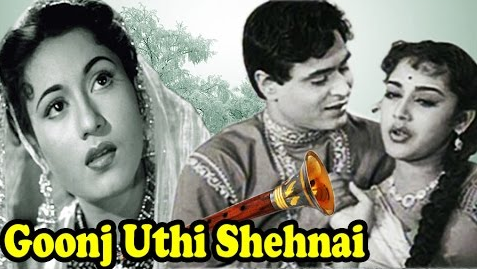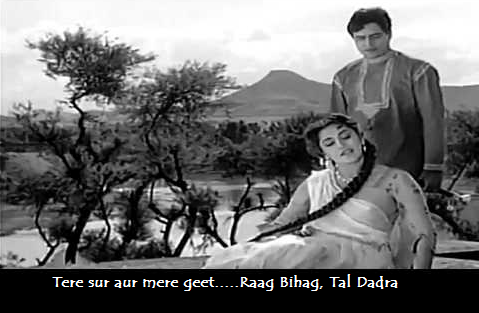Raaga Based Song of the Day: Tere sur aur mere geet….
Raag Bihag, Tal Dadra.
We have completed five days of Raaga Based Songs of the Day and hence it is not such a new series on this blog anymore. Our first post in the series was titled ‘Raaga Based Song Of The Day #1’ and the song was a Mohammad Rafi and Lata Mangeshkar song from the 1970 Shakti Samanta movie Pagla Kahin Ka: Tum mujhe youn bhula na paoge. It is in Raag Jhinjhoti, Tal Kaherava.
Our fifth post or the last post was titled ‘Raaga Based Song Of The Day #5’ and the song was a Mohammad Rafi and Suman Kalyanpur song from the 1964 Hrishikesh Mukherjee movie Sanjh Aur Savera: Ajahun na aaye balma sawan beeta jaaye. It is in Raag Madhuvanti, Tal Kaherava.
This blog has a number of posts on Raaga based songs in Hindi movies titled similarly; for example: ‘The Best Raaga Based Songs in Hindi Movies – Raag Yaman – Part -I’.
This is from the 1959 Vijay Bhatt movie Goonj Uthi Shehnai, seven years after he made Baiju Bawra, the only movie for which Naushad received his only Filmfare Award (though later he was conferred with the highest, ie, Dadasaheb Phalke Award. Just like Baiju Bawra, this film too had great songs such as Jivan mein piya tera saath rahe (Raag Gara), Keh do koi na kare yahan pyaar (Raag Jogiya), and Dil ka khilauna haay toot gaya (Bhairavi).

The song was put together by lyricist Bharat Vyas and composer Vasant Desai, a great team that gave us Ai malik tere bande hum.
Lata Mangeshkar sang it.
Raag Bihag belongs to Bilawal Thaat and is a late night song. It is a wedding raag since it is both romantic and celebratory.
Goonj Uthi Shehnai is the story of a Shehnai player Rajendra Kumar. The success of the movie made him very famous. Throughout the movie there is Shehnai recital by the greatest Shehnai player in India Ustaad Bismillah Khan who was conferred the highest award Bharat Ratna in 2001 together with Lata Mangeshkar, three years after MS Subbulakshmi and two years after Pandit Ravi Shankar.
What about our value added learning for today? Today, let’s briefly learn about the ‘mood’ of the raag that explains why Raag means colour, hue or tinge.
For instance, anybody who talks about Raag Darbari Kanada (a raag that Tansen brought from the South (Carnatic Music) to the North (Hindustani Music), into the court of Akbar in the 17th century) would know that the raag has a majestic touch about it, eg, Guzren hain aaj ishq mein ham us mukaam se, and Main nigaahen tere chehre se hataayun kaise?
There are the following eight Ras (sentiments) in the Raagas as given in Bharat Batya Shastra:
1. Shringaar (romantic).
2. Veer (heroic).
3. Hasya (comic).
4. Rudra (wrathful).
5. Bhayanak (terrifying).
6. Bibhatsa (odious).
7. Karuna (pathos).
8. Adhbhut (wondrous).
Later, another ras Shant (calm or peaceful) was added and the entire list was called Navras.
Naturally, Bihag belongs to Shringaar Ras.
Please enjoy Lata Mangeshkar sing in Raag Bihag, Tal Dadra: Tere sur aur mere geet…
Tere sur aur mere giit
tere sur aur mere giit
dono mil kar banegii priit
tere sur aur mere giit
(dha.Dakan me.n tuu hai samaayaa huaa
khayaalo.n me.n tuu hii tuu chhaayaa huaa) – 2
duniyaa ke mele me.n laakho.n mile
magar tuu hii tuu dil ko bhaayaa huaa
mai.n terii jogan tuu meraa miit
dono mil kar banegii priit
tere sur aur mere giit
(mujhako agar bhuul jaaoge tum, aa aa aaaa
mujhase agar duur jaoge tum ) – 2
merii muhabbat me.n taasiir hai, aa aa aaaa
merii muhabbat me.n taasiir hai
to khii.nch ke mere paas aaoge tum
dekho hamaarii hogii jiit
dono mil kar banegii priit
tere sur aur mere giit
P.S. Please enjoy Bismillah Khan’s Shehnai immediately after Lata’s alaap.
We have intended to learn about Raaga based music whilst we entertain ourselves with Raaga based songs. So, lets, once again, take stock of our collective learning so far:
- On the first day we learnt about the Raaga system devised by Pandit Vishnu Narayan Bhatkhande, which is the prevalent system in Hindustani Classical Music and based on ten Thaats.
- On the second day we learnt about Tal or Taal.
- On the third day we learnt about characteristics of Raagas that included Swar, Jati, Thaat, Arohana and Avarohana, Vadi, Samvadi and Pakad.
- On the fourth day, we learnt about Sargam.
- On the fifth day, we learnt about notations used in Indian classical music or simply Swar Lipi.
- On the sixth day, that is, today, we learnt about the Ras (sentiments) that Raagas evoke.
There is much more still to be learnt and enjoyed.
Please stay tuned!
